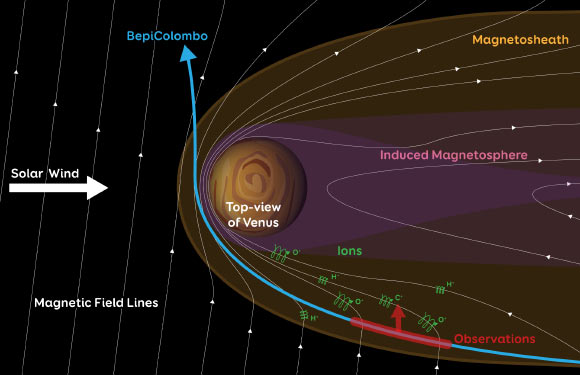In August 2021, the ESA/JAXA Mercury-bound BepiColombo spacecraft performed its second flyby of Venus and provided a short-lived observation of its induced magnetosphere. The spacecraft detected cold oxygen and carbon ions at a distance of about six planetary radii in a region of the magnetosphere that has never been explored before.
Schematic view of planetary material escaping through Venus magnetosheath flank; the red line and arrow show the region and direction of observations by BepiColombo when the escaping ions (C+, O+, H+) were observed. Image credit: Thibaut Roger / Europlanet 2024 RI / Hadid et al.
During its formation, Venus was similar to Earth in many ways, including the existence of substantial amounts of liquid water.
However, Venus eventually evolved in a divergent way, leading to substantial differences between the two planets.
Unlike Earth, Venus is now an extremely dry planet that lacks an intrinsic magnetic field.
The continuous impact of the solar wind on the atmospheres of both planets results in important atmospheric losses.
The atmosphere of Venus, predominantly composed of carbon dioxide with smaller amounts of nitrogen and other minor species, is affected by interactions with the solar wind, leading to important ion outflows.
“This is the first time that positively charged carbon ions have been observed escaping from Venus’ atmosphere,” said Dr. Lina Hadid, a researcher at the Plasma Physics Laboratory and CNRS.
“These are heavy ions that are usually slow moving, so we are still trying to understand the mechanisms that are at play.”
“It may be that an electrostatic ‘wind’ is lifting them away from the planet, or they could be accelerated through centrifugal processes.”
“Unlike Earth, Venus does not generate an intrinsic magnetic field in its core.”
“Nonetheless, a weak, comet-shaped ‘induced magnetosphere’ is created around the planet by the interaction of charged particles emitted by Sun (solar wind) with electrically charged particles in Venus’ upper atmosphere.”
“Draped around the magnetosphere is a region called the ‘magnetosheath’ where the solar wind is slowed and heated.”
On August 10, 2021, BepiColombo passed by Venus to slow down and adjust course towards its final destination of Mercury.
The spacecraft swooped up the long tail of the planet’s magnetosheath and emerged through the nose of the magnetic regions closest to the Sun.
Over a 90-minute period of observations, BepiColombo’s Mass Spectrum Analyzer (MSA) and the Mercury Ion Analyzer (MIA) measured the number and mass of charged particles it encountered, capturing information about the chemical and physical processes driving atmospheric escape in the flank of the magnetosheath.
“Characterizing the loss of heavy ions and understanding the escape mechanisms at Venus is crucial to understand how the planet’s atmosphere has evolved and how it has lost all its water,” said MSA’s principal investigator Dr. Dominique Delcourt, a researcher at the Plasma Physics Laboratory.
“This result shows the unique results that can come out of measurements made during planetary flybys, where the spacecraft may move through regions generally unreachable by orbiting spacecraft,” said Dr. Nicolas André, a researcher at the Institut de Recherche en Astrophysique et Planétologie.
The study was published in the journal Nature Astronomy.
_____
L.Z. Hadid et al. BepiColombo observations of cold oxygen and carbon ions in the flank of the induced magnetosphere of Venus. Nat Astron, published online April 12, 2024; doi: 10.1038/s41550-024-02247-2


